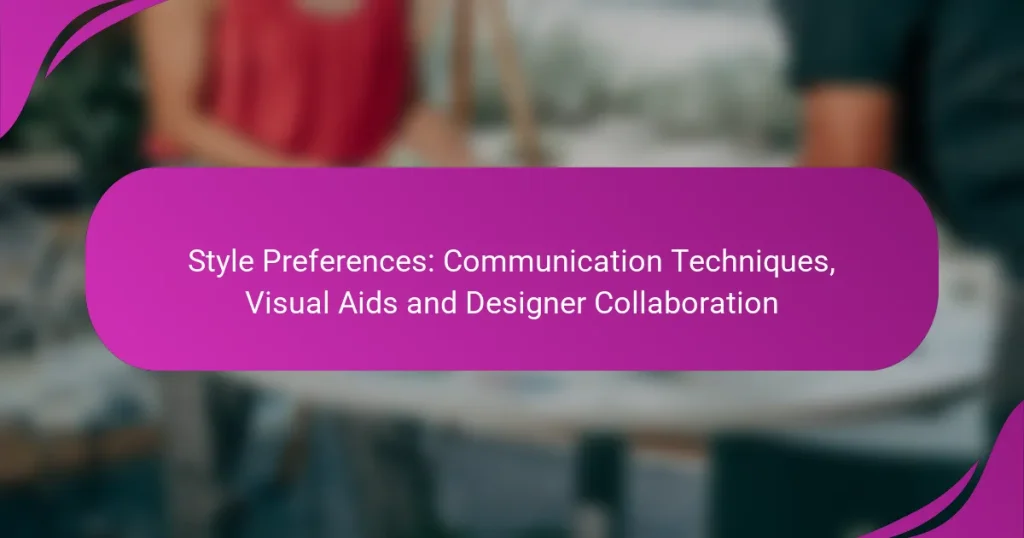In the realm of design, effective communication techniques are essential for fostering collaboration and ensuring project success. By utilizing active listening, clear messaging, and visual aids, designers can enhance understanding and alignment among team members. Structured collaboration practices further streamline workflows and boost creativity, ultimately leading to more successful outcomes.

What are effective communication techniques for designers in Canada?
Effective communication techniques for designers in Canada include active listening, clear messaging, feedback loops, and the use of collaborative tools. These strategies enhance collaboration, streamline processes, and ensure that design projects meet client expectations.
Active listening
Active listening involves fully concentrating on what is being said rather than just passively hearing the speaker. For designers, this means engaging with clients and team members to understand their needs and perspectives. Techniques such as summarizing what has been said or asking clarifying questions can significantly improve comprehension and rapport.
In a Canadian context, cultural nuances may influence communication styles. Being aware of these differences can help designers connect better with diverse clients and stakeholders.
Clear and concise messaging
Clear and concise messaging is crucial for effective communication in design. This involves using straightforward language and avoiding jargon that may confuse clients or team members. Designers should aim to convey ideas in a way that is easily understood, often using visuals to complement verbal or written communication.
For instance, when presenting design concepts, using simple diagrams or mockups can clarify complex ideas and facilitate better discussions. Keeping messages brief helps maintain attention and ensures that key points are not lost.
Feedback loops
Feedback loops are essential for refining design work and ensuring alignment with client expectations. Establishing regular check-ins and review sessions allows designers to gather input and make necessary adjustments throughout the project lifecycle. This iterative process fosters collaboration and enhances the final outcome.
In Canada, it is beneficial to create a structured feedback process that includes specific timelines and methods for collecting input, such as surveys or direct discussions. This approach can help manage expectations and improve satisfaction with the design process.
Use of collaborative tools
Utilizing collaborative tools can significantly enhance communication among designers and their teams. Platforms like Slack, Trello, or Figma allow for real-time collaboration, file sharing, and project management. These tools help keep everyone on the same page and streamline workflows.
When selecting collaborative tools, consider the specific needs of your team and clients. Look for features that facilitate easy communication and feedback, and ensure that all team members are comfortable using the chosen platforms to maximize their effectiveness.

How can visual aids enhance designer communication?
Visual aids significantly improve designer communication by providing clear, concise representations of ideas, concepts, and data. They facilitate understanding and collaboration among team members, ensuring everyone is aligned on project goals and expectations.
Infographics for data representation
Infographics effectively present complex data in a visually engaging format, making it easier for designers and stakeholders to grasp key insights quickly. They can include charts, graphs, and icons to summarize information, which is particularly useful in presentations or reports.
When creating infographics, focus on clarity and simplicity. Use a limited color palette and consistent fonts to enhance readability. Aim for a balance between informative content and visual appeal to maintain audience engagement.
Storyboards for project visualization
Storyboards are essential for visualizing project workflows and user experiences. They allow designers to map out sequences of events or interactions, helping teams visualize how a user will navigate through a product or service.
To create effective storyboards, break down the project into key scenes or steps. Use sketches or digital tools to illustrate each stage, ensuring that the narrative flows logically. This approach can identify potential issues early in the design process, saving time and resources.
Mockups for design concepts
Mockups serve as detailed representations of design concepts, allowing designers to showcase their ideas before final production. They provide a realistic view of the final product, including layout, colors, and typography, which aids in gathering feedback from stakeholders.
When developing mockups, consider using tools like Adobe XD or Figma for interactive prototypes. Keep in mind that high-fidelity mockups can take time to create, so prioritize key screens that require feedback. This ensures that the design aligns with user needs and project goals before moving forward.

What are best practices for designer collaboration?
Effective designer collaboration hinges on communication, organization, and clarity. By implementing structured practices, teams can enhance creativity and streamline project workflows.
Regular check-ins
Regular check-ins are crucial for maintaining alignment among team members. These meetings should occur at consistent intervals, such as weekly or bi-weekly, to discuss progress, address challenges, and adjust priorities as needed.
During check-ins, encourage open dialogue and feedback. This not only fosters a collaborative environment but also helps identify potential issues early, allowing for timely resolutions.
Utilizing project management software
Project management software can significantly enhance designer collaboration by providing a centralized platform for task management, file sharing, and communication. Tools like Trello, Asana, or Monday.com allow teams to track progress and deadlines effectively.
Choose software that fits your team’s workflow and preferences. Ensure all members are trained on its features to maximize efficiency and minimize confusion. Regularly review and update tasks to keep everyone informed and engaged.
Establishing clear roles
Establishing clear roles within the design team is essential for effective collaboration. Each member should understand their responsibilities and how they contribute to the overall project goals, which reduces overlap and confusion.
Consider creating a roles matrix that outlines each person’s duties, deadlines, and points of contact. This clarity helps streamline communication and ensures accountability, leading to a more productive design process.

What tools facilitate designer communication in Canada?
In Canada, effective designer communication is supported by various tools that enhance collaboration and streamline workflows. Key platforms like Slack, Trello, and Zoom are commonly used to facilitate messaging, task management, and virtual meetings, respectively.
Slack for messaging
Slack is a popular messaging platform that allows designers to communicate in real-time through channels and direct messages. It supports file sharing, which is essential for exchanging design drafts and feedback quickly.
To maximize Slack’s effectiveness, create dedicated channels for specific projects or teams. This organization helps keep conversations focused and reduces noise from unrelated discussions.
Trello for task management
Trello is a visual task management tool that uses boards, lists, and cards to organize projects. Designers can track progress, assign tasks, and set deadlines, making it easier to collaborate on design workflows.
Utilize Trello’s features like checklists and due dates to ensure accountability among team members. Regularly updating the board can help maintain clarity on project status and priorities.
Zoom for virtual meetings
Zoom is a widely used platform for virtual meetings, allowing designers to connect face-to-face regardless of location. It supports screen sharing, which is crucial for discussing design elements in real-time.
To enhance meeting productivity, set clear agendas and invite only necessary participants. Recording meetings can also be beneficial for reference and for team members who cannot attend live sessions.

What criteria should be considered for selecting design collaboration tools?
When selecting design collaboration tools, consider user-friendliness, integration capabilities, and cost-effectiveness. These criteria ensure that the tools enhance teamwork and streamline the design process without unnecessary complications.
User-friendliness
User-friendliness is crucial for ensuring that all team members can effectively engage with the design collaboration tools. Look for intuitive interfaces that minimize the learning curve, allowing users to focus on their creative work rather than struggling with technology.
Consider tools that offer features like drag-and-drop functionality and customizable dashboards. User reviews and trial versions can provide insight into how easy a tool is to navigate, helping you make an informed choice.
Integration capabilities
Integration capabilities determine how well a design collaboration tool can work with other software your team uses. Tools that seamlessly connect with project management, communication, and design software can significantly enhance workflow efficiency.
Evaluate whether the tool supports popular integrations such as Slack, Trello, or Adobe Creative Cloud. A tool with strong integration capabilities can reduce redundancy and streamline processes, making it easier for teams to collaborate effectively.
Cost-effectiveness
Cost-effectiveness is essential when selecting design collaboration tools, especially for teams with budget constraints. Assess the pricing models of various tools, including subscription fees, one-time payments, and any additional costs for premium features.
Look for tools that offer tiered pricing plans, allowing you to choose a package that fits your team’s size and needs. Additionally, consider the potential return on investment; a more expensive tool may save time and improve productivity, justifying the cost.

How do cultural differences impact design communication in Canada?
Cultural differences significantly influence design communication in Canada, affecting how designers and clients interact. Understanding these nuances can enhance collaboration and lead to more effective design outcomes.
Communication Techniques
In Canada, communication styles can vary widely between regions and cultural backgrounds. Generally, Canadians favor a polite and indirect approach, valuing consensus and collaboration. This means that designers should be attentive to non-verbal cues and be prepared for discussions that prioritize group input.
To navigate these differences, consider using open-ended questions during meetings to encourage dialogue. Avoid aggressive or overly direct language, as it may be perceived as confrontational. Instead, aim for a tone that promotes inclusivity and respect.
Visual Aids
Visual aids play a crucial role in bridging communication gaps in design. In Canada, using clear and culturally relevant imagery can enhance understanding and engagement. Designers should ensure that visuals resonate with diverse cultural perspectives present in the Canadian market.
When creating presentations or design mockups, incorporate local elements or symbols that reflect Canadian identity. This not only aids comprehension but also fosters a sense of connection with the audience. Keep visuals simple and uncluttered to maintain focus on key messages.
Designer Collaboration
Collaboration among designers in Canada often requires sensitivity to cultural differences. Team dynamics can be influenced by varying approaches to hierarchy and decision-making. For instance, some cultures may prefer a more egalitarian approach, while others might lean towards a structured hierarchy.
To facilitate effective collaboration, establish clear roles and responsibilities from the outset. Regular check-ins can help ensure that all team members feel valued and heard. Be open to feedback and adapt your collaborative style to accommodate the diverse preferences of your team members.


